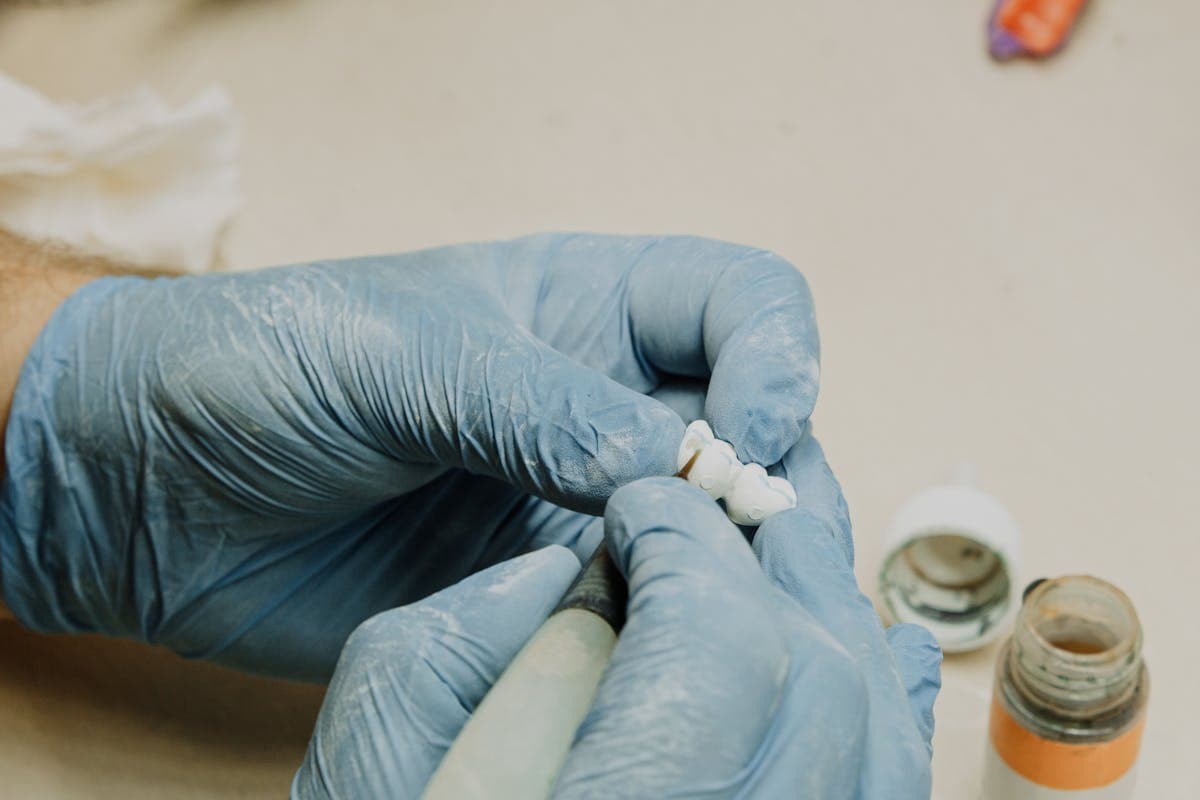In the domain of restorative dentistry, crowns and bridges are commonly utilized interventions. Yet, despite their widespread use, there is often confusion about their distinct roles and benefits. A comprehension of the unique functionality of crowns, fundamentally acting as a protective cap for a compromised tooth, juxtaposed with the role of bridges, designed to substitute absent teeth, is pivotal. This understanding informs not only the selection of appropriate dental solutions but also the success of oral health outcomes. Let’s dissect these two dental prosthetics further.
Understanding Dental Crowns
Dental crowns, often referred to as “caps,” are customized prosthetic elements used in dentistry. They are designed to restore the size, shape, and functionality of a damaged tooth and can be made from various materials, which are categorized into different crown types.
These types include metal, porcelain-fused-to-metal, all-resin, and all-ceramic. Metal crowns are known for their durability while porcelain and ceramic crowns offer an aesthetic appeal that closely resembles natural teeth.
The crown benefits extend beyond aesthetics. Crowns strengthen weakened teeth, protect them from further decay, and restore the overall alignment of your bite. They also alleviate discomfort during chewing and improve speech impediments caused by tooth loss. The strategic application of dental crowns can greatly enhance oral health and contribute to a confident smile.
The Purpose of Dental Bridges
Bridges, another integral part of restorative dentistry, serve a crucial role in filling the gaps left by missing teeth. The primary purpose of dental bridges is to restore the function and aesthetics of a healthy mouth. Functionally, bridges restore the ability to chew and speak properly, which can be greatly hindered by missing teeth. They also maintain the shape of the face and distribute the forces in your bite correctly by replacing missing teeth. From an aesthetic perspective, bridges improve smile appearance by filling in gaps with prosthetic teeth that look and feel natural. As a result, dental bridges provide both functional benefits and aesthetic appeal, contributing greatly to oral health and self-confidence.
Materials Used for Crowns
As we proceed with our discussion on crowns, it becomes essential to understand the materials utilized in their creation. Our focus will be on the popular choices of crown material, each with its unique pros and cons. The evaluation of these materials will pivot on two important factors - durability and aesthetics.
Popular Crown Material Choices
Choosing the right material for a dental crown is a critical decision that can greatly impact its durability and aesthetic appeal. Ceramic crowns, often chosen for their natural appearance, are a popular choice for front teeth. Metal crowns, known for their longevity, are typically used for molars due to their visible metallic color. Porcelain crowns offer a balance between aesthetics and durability, providing a natural-looking option that is stronger than ceramic. Resin crowns are an affordable option, but may not last as long due to their susceptibility to wear. Zirconia crowns, on the other hand, offer a blend of strength, longevity, and aesthetics, making them a popular choice. Each material has its advantages and trade-offs with regard to crown affordability, aesthetics, and longevity.
Evaluating Durability and Aesthetics
Understanding the different materials utilized for dental crowns is a significant part of the decision-making process. Primarily, the longevity comparison between various materials is key in determining durability. For instance, porcelain and gold crowns are known for their endurance over extended periods, often outlasting other types such as resin-based crowns.
Simultaneously, aesthetic considerations are essential. While gold crowns offer high durability, they may not provide the same natural look as porcelain or ceramic crowns. Consequently, a balance must be sought between durability and aesthetics. The choice often depends on the specific needs of the patient, including the location of the crown, their personal preference, and overall oral health status.

Materials Used for Bridges
Though they may appear similar to the untrained eye, the materials used for bridges vary widely, each offering unique benefits and potential drawbacks. Dental bridges are typically composed of either ceramic options or metal alloys. Ceramic bridges, often made from porcelain, are popular due to their natural appearance and strength. They are highly resistant to staining and offer a pleasing aesthetic that can closely mimic natural teeth. On the other hand, metal alloys, often a mixture of several metals including gold, copper and nickel, are lauded for their durability. These materials are resilient to wear and tear, making them a long-lasting choice. However, they may lack the natural look that ceramic options offer. The choice between ceramic and metal depends on the patient’s needs and preferences.
Procedure for Crown Placement
The process for placing a dental crown is a meticulous one, involving several key steps to guarantee a perfect fit and seamless blend with the surrounding teeth. Initially, the dentist reshapes the tooth to make space for the crown. Then, an impression of the reshaped tooth and surrounding teeth is taken to create a custom-fit crown. Crown types vary depending on the material used, but options commonly include porcelain, ceramic, and metal. Once prepared, the crown is cemented onto the reshaped tooth. The crown benefits are manifold: it restores the tooth’s shape, size, and function; protects the underlying tooth; and improves the overall aesthetic of the patient’s smile. This procedure typically requires two visits to the dentist.
Procedure for Bridge Installation
Just as with a crown, the installation of a dental bridge is a detailed process that involves multiple steps to guarantee an accurate fit and natural appearance. First, the abutment teeth are prepared by recontouring them to allow room for the bridge to be placed over them. Impressions of the teeth are then taken, which serve as a model for the dental lab to create the bridge. The bridge types range from traditional, cantilever to Maryland bonded bridges, each serving different patient needs. A temporary bridge is worn until the custom one is ready. During a subsequent visit, the temporary bridge is removed, and the new bridge is adjusted and cemented over the prepared teeth, completing the installation steps.
Maintenance of Dental Crowns
Maintaining dental crowns is an essential practice that guarantees their longevity and functionality. Proper crown care involves regular brushing and flossing, just like your natural teeth. However, it’s vital to use non-abrasive toothpaste and a soft-bristled toothbrush to avoid scratching the crown’s surface. In addition, avoiding hard or sticky food can prevent physical damage or dislodgement. Routine check-ups are indispensable in ensuring that the crown is in good condition and functioning correctly. During these visits, your dentist can detect any signs of wear or potential issues that could compromise the crown’s effectiveness. Remember, diligent care extends the life of your dental crowns and helps maintain your overall oral health.
Maintenance of Dental Bridges
Similar to dental crowns, bridges also necessitate a rigorous and consistent hygiene routine to guarantee their durability and proper function. A key aspect of bridge care involves regular brushing and flossing to prevent the buildup of plaque and decay-causing bacteria. It’s important to use a soft-bristled toothbrush and non-abrasive toothpaste to avoid damaging the material of the bridge. Additionally, interdental brushes and floss threaders can be used to clean underneath the bridge and around the abutment teeth. Regular professional cleanings and check-ups are also foundational to maintaining the integrity of the bridge. Ultimately, a diligent oral hygiene regimen is crucial for the longevity and efficacy of dental bridges.
Frequently Asked Questions
Can Crowns and Bridges Be Whitened Like Natural Teeth?
No, crowns and bridges cannot be whitened like natural teeth. Whitening methods only work on natural tooth enamel and may lead to uneven color and increased tooth sensitivity if applied to these dental restorations.
What Is the Average Life Span of Dental Crowns and Bridges?
The average lifespan of dental crowns and bridges varies, typically between 5-15 years. Longevity factors include oral hygiene and regular dental visits. Maintenance tips include avoiding hard foods and practicing good oral hygiene.
Are There Any Dietary Restrictions After Getting a Crown or Bridge?
Post-procedure care for both crowns and bridges involves careful food choices. Initially, avoid hard, sticky, or chewy foods to prevent dislodgement. Long term, balanced diet is key to maintaining the integrity of the restoration.
What Are the Potential Complications or Risks of Crowns and Bridges?
Potential complications of crowns include tooth sensitivity, gum disease, and potential for chipping. Bridge risks encompass structural damage to adjacent teeth, potential for decay, and potential need for root canal treatment. Regular dental check-ups can mitigate these risks.
Does Insurance Typically Cover the Cost of Dental Crowns and Bridges?
Insurance coverage for dental crowns and bridges largely depends on the specifics of individual dental plans. Some insurers may cover a portion of the cost, while others may not. It’s advised to check with your provider.


